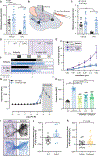Transient receptor potential canonical 5 mediates inflammatory mechanical and spontaneous pain in mice
- PMID: 34039739
- PMCID: PMC8923002
- DOI: 10.1126/scitranslmed.abd7702
Transient receptor potential canonical 5 mediates inflammatory mechanical and spontaneous pain in mice
Abstract
Tactile and spontaneous pains are poorly managed symptoms of inflammatory and neuropathic injury. Here, we found that transient receptor potential canonical 5 (TRPC5) is a chief contributor to both of these sensations in multiple rodent pain models. Use of TRPC5 knockout mice and inhibitors revealed that TRPC5 selectively contributes to the mechanical hypersensitivity associated with CFA injection, skin incision, chemotherapy induced peripheral neuropathy, sickle cell disease, and migraine, all of which were characterized by elevated concentrations of lysophosphatidylcholine (LPC). Accordingly, exogenous application of LPC induced TRPC5-dependent behavioral mechanical allodynia, neuronal mechanical hypersensitivity, and spontaneous pain in naïve mice. Lastly, we found that 75% of human sensory neurons express TRPC5, the activity of which is directly modulated by LPC. On the basis of these results, TRPC5 inhibitors might effectively treat spontaneous and tactile pain in conditions characterized by elevated LPC.
Copyright © 2021 The Authors, some rights reserved; exclusive licensee American Association for the Advancement of Science. No claim to original U.S. Government Works.
Conflict of interest statement
Figures






Comment in
-
TRPC5 and the path towards analgesic drug development.Trends Neurosci. 2021 Sep;44(9):687-688. doi: 10.1016/j.tins.2021.06.010. Epub 2021 Jul 14. Trends Neurosci. 2021. PMID: 34274149
Similar articles
-
Lysophospholipids Contribute to Oxaliplatin-Induced Acute Peripheral Pain.J Neurosci. 2020 Dec 2;40(49):9519-9532. doi: 10.1523/JNEUROSCI.1223-20.2020. Epub 2020 Nov 6. J Neurosci. 2020. PMID: 33158961 Free PMC article.
-
Optogenetic Inhibition of CGRPα Sensory Neurons Reveals Their Distinct Roles in Neuropathic and Incisional Pain.J Neurosci. 2018 Jun 20;38(25):5807-5825. doi: 10.1523/JNEUROSCI.3565-17.2018. J Neurosci. 2018. PMID: 29925650 Free PMC article.
-
BTD: A TRPC5 activator ameliorates mechanical allodynia in diabetic peripheral neuropathic rats by modulating TRPC5-CAMKII-ERK pathway.Neurochem Int. 2023 Nov;170:105609. doi: 10.1016/j.neuint.2023.105609. Epub 2023 Sep 5. Neurochem Int. 2023. PMID: 37673218
-
Transient receptor potential canonical 5 (TRPC5) protects against pain and vascular inflammation in arthritis and joint inflammation.Ann Rheum Dis. 2017 Jan;76(1):252-260. doi: 10.1136/annrheumdis-2015-208886. Epub 2016 May 10. Ann Rheum Dis. 2017. PMID: 27165180 Free PMC article.
-
Sex-Dependent Reduction in Mechanical Allodynia in the Sural-Sparing Nerve Injury Model in Mice Lacking Merkel Cells.J Neurosci. 2021 Jun 30;41(26):5595-5619. doi: 10.1523/JNEUROSCI.1668-20.2021. Epub 2021 May 24. J Neurosci. 2021. PMID: 34031166 Free PMC article.
Cited by
-
Transient Receptor Potential Channel 4 Small-Molecule Inhibition Alleviates Migraine-Like Behavior in Mice.Front Mol Neurosci. 2021 Nov 1;14:765181. doi: 10.3389/fnmol.2021.765181. eCollection 2021. Front Mol Neurosci. 2021. PMID: 34790097 Free PMC article.
-
TRPC4 Mediates Trigeminal Neuropathic Pain via Ca2+-ERK/P38-ATF2 Pathway in the Trigeminal Ganglion of Mice.CNS Neurosci Ther. 2025 Apr;31(4):e70368. doi: 10.1111/cns.70368. CNS Neurosci Ther. 2025. PMID: 40202077 Free PMC article.
-
Neuropathic pain has sex-specific effects on oxycodone-seeking and non-drug-seeking ensemble neurons in the dorsomedial prefrontal cortex of mice.Addict Biol. 2024 Aug;29(8):e13430. doi: 10.1111/adb.13430. Addict Biol. 2024. PMID: 39121884 Free PMC article.
-
Keratinocyte PIEZO1 modulates cutaneous mechanosensation.Elife. 2022 Sep 2;11:e65987. doi: 10.7554/eLife.65987. Elife. 2022. PMID: 36053009 Free PMC article.
-
Sickle cell disease iPSC-derived sensory neurons exhibit increased excitability and sensitization to patient plasma.Blood. 2024 May 16;143(20):2037-2052. doi: 10.1182/blood.2023022591. Blood. 2024. PMID: 38427938 Free PMC article.
References
-
- Szczot M, Liljencrantz J, Ghitani N, Barik A, Lam R, Thompson JH, Bharucha-Goebel D, Saade D, Necaise A, Donkervoort S, Foley AR, Gordon T, Case L, Bushnell MC, Bönnemann CG, Chesler AT, PIEZO2 mediates injury-induced tactile pain in mice and humans. Sci. Transl. Med 10, eaat9892 (2018). - PMC - PubMed
Publication types
MeSH terms
Grants and funding
LinkOut - more resources
Full Text Sources
Other Literature Sources
Medical
Molecular Biology Databases

